Tire Sealant 2018 Update
As resident Tire Geek Extraordinaire here at Slowtwitch, I thought it was about time for an update on the state of tire sealants. I’ve written extensively about tire sealants – HERE, HERE, and HERE. For the uninitiated, tire sealant amounts to liquid fix-a-flat. Most require that you squirt the sealant into your tire before riding, and the hope is that – if you get a puncture – the sealant will automatically plug the hole before the tire loses too much air. In a perfect scenario, you can keep on riding like nothing happened. There is a second method, where sealants are sold as a canister with pressurized gas to fix a tire that’s already gone flat. I’ll call it post-flat-fix-a-flat. Examples include Vittoria’s Pit Stop and Effetto Mariposa Espresso, pictured below:
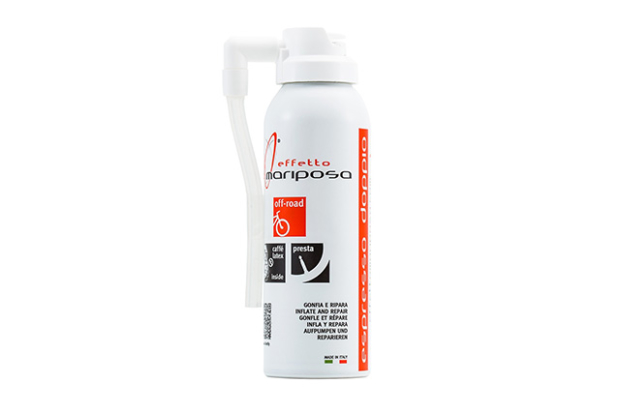
The big tire sealant test (linked above) took a tremendous amount of time and seemed to make some waves, but I’ll be honest – I haven’t seen much in the way of real application in the marketplace. Let me explain.
About 10 years ago, I thought tire sealant technology would continue to advance at a rapid rate, to the point that we would use it for all our bikes (regardless of whether those bikes have tubeless tires, tubular tires, or good ol’ clincher tires with inner tubes). My sealant test showed substantial variation between the best and worst performers. I thought that by 2015 or 2020, flat tires would be virtually non-existent.
Turns out, I was both right and wrong. Sealants have continued to improve. More people are using them. But there is plenty of room for more education and improvement, and flat tires definitely still exist. Also, I don’t see any major changes coming in the next decade, unless there is a truly unforeseen innovation that achieves the holy trilogy of ease-of-use, effectiveness, and low price.
Today, we’ll go through the need-to-know tire sealant updates for each of the three major tire types, along with some general commentary on the latest innovations.
Tubular Tires
Tubular tires. Does anyone still ride them?
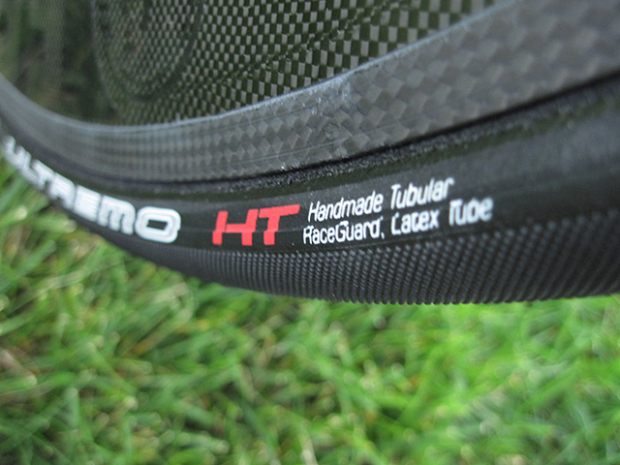
I’m joking, but let’s be honest – tubular tires and wheels have drastically declined in popularity for everyone except professional cycling teams (and even some teams use clincher tires for things like time trials). They can be super light weight, but it seems that the chore of gluing tires isn’t worth the trouble for the average Joe or Jane.
That said, tubular tires are one place where – at least on paper – tire sealants should absolutely be used. You can’t just change the inner tube in the event of a flat tire. It takes some real work to swap tires and properly glue a new one onto your wheel. The majority of tubular users simply do not have the skills or knowledge to change a flat during a race, even if they brought a pre-glued spare with them. The small chance that a tire sealant could fix the puncture during a race seems irresistible. Yes, that does mean that adding back a bit of weight that you were trying to lose by going with tubulars in the first place. I don’t think it’s worth worrying about, and I’ve certainly seen more than one tubular-riding-athlete attach multiple Co2/sealant canisters to their bike in case of disaster – adding an aerodynamic penalty on top of the weight penalty. My opinion: just put the sealant in your tires ahead of time and cross your fingers.
That said, there is one VERY important consideration at hand. My sealant test from years back tested the effectiveness of sealants for a few puncture sizes, but did not evaluate longevity (i.e. how shelf-stable they are over time). The top performing sealant in the test was Bontrager TLR. I ran this sealant in a bike with tubeless tires, and noticed that it was continuously ‘weeping’ out of the tires – not entirely uncommon. Having decided to top off the sealant level, I opened a new bottle that had sat on the shelf in my garage – fully sealed – for about 2 years. I found that the sealant had completely separated in to what looked like water and big chunks of hardened latex. No amount of shaking would re-mix it, and I had to throw it out. Texas-based Orange Seal recommends a 1-year shelf life. With more than one brand of sealant, I’ve ended up with separate chunks and liquid in my tires/tubes, along with the obvious drop in the sealants’ effectiveness.
My now-dead TLR sealant:
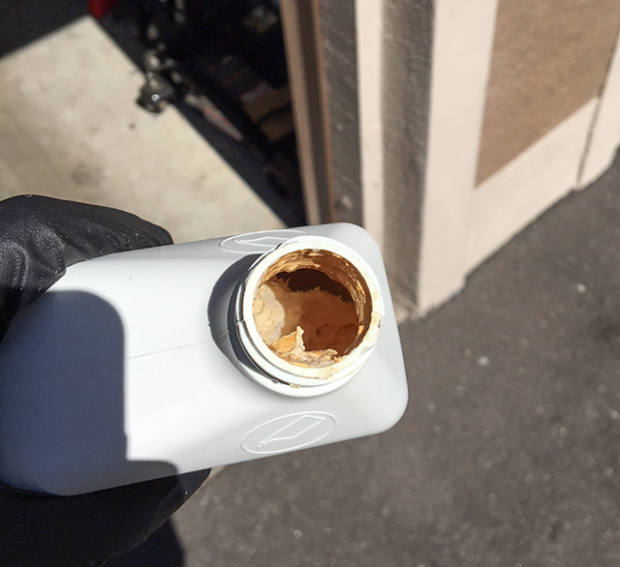
Translation: by installing some sealants, you’re starting a clock on the life of your tubular tires even if you put very few miles on them (and I don’t have to tell you that those can be some expensive tires). How much is the insurance of sealant worth to you?
Tube-Type Tires (a.k.a. Clincher Tires)
This is the category that most surprised me. I thought – ‘Why NOT use a sealant in an inner tube? It’s such cheap insurance! Even if it eventually glues the tube shut inside, it’s a very inexpensive replacement compared to a tubular tire!’
It never quite panned out that way in the real world for me. Sealants CAN work in inner tubes. I just haven’t found that they work well enough to justify the cost and potential mess/hassle.
I used inner tube sealant big-time for several years. I’d still likely use it for racing, if it was a large event that meant a lot to me and I wanted to take every precaution.
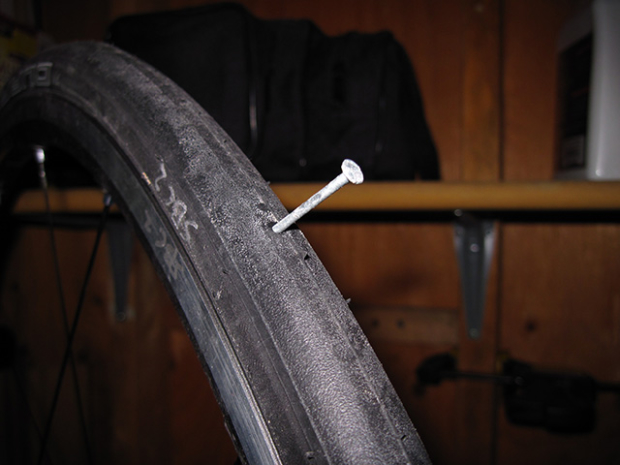
For my training tires and day-to-day riding, sometimes the sealant worked and fixed the flat, and sometimes it didn’t. The biggest problem, however, applies to all three tire types – and that’s glued valve cores. Sealant exists to plug holes… but it isn’t smart enough to know the difference between a tread puncture and your tire’s valve. With some brands of sealant, I replaced the valve cores at least every couple months, because otherwise I’d have a heck of a time trying to pump up my tires (and with one brand my valves were 100% glued shut). Also when you pump up the tires, sealant often spits out, gradually gumming up your pump head and wheels. Because of these issues, I found myself slowly moving away from sealant-in-tubes for my everyday riding. On top of that, I moved from Michigan to Florida and the change in road surface conditions alone dramatically reduced my number of flat tires. If I still lived in a very flat-prone area, I might have stuck with sealant.
Tubeless Tires
Tubeless tires are still the proper home for tire sealants. They function best here, because there’s only one layer of material that needs to be sealed – the tire. Clincher and tubular tires both have two layers that need sealing in the event of a puncture (the tire and tube), which seems to reduce the sealing ability of ALL tire sealants. The two layers move semi-independently, making it difficult to achieve a good seal on both layers.
Short of the virtually-dead UST mountain bike standard, you MUST use a sealant with tubeless tires (and it must be intended specifically for this application). It helps seal any small imperfections in the surfaces where the tire and rim join together. The sealant fills in the gaps to create an air-tight tire. There is news of an emerging road UST standard gaining acceptance, but personally I would use a sealant even if it is not required.
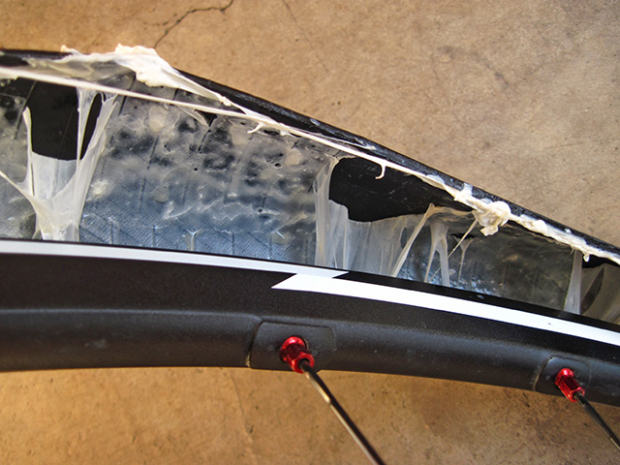
That said, just because you have tubeless tires and sealant does not mean that you’re immune to flat tires. In fact, many of the new tubeless road tires are being made thinner and thinner on a quest for faster rolling resistance numbers. Translation: some tubeless tires, despite having sealant, are more fragile than the regular clincher tire/tube setups. Sealant can’t fix large cuts, and thin casings don’t hold their shape very well (which makes sealants less effective). It seems there is no free lunch to be had when it comes to sealants.
My advice is that if you’re using tubeless tires, do your research. If you use a racing tire with super low rolling resistance, you are signing up for just as much risk as those using tubulars or standard clincher tires. If that’s not okay with you, buy a thicker tire. Also, tubeless tires still have hit-and-miss installation. I’ve run in to tires so tight that I’ve had to cut them off the wheels (on three occasions that I can recall). If this happens when you’re out on the road, you’re calling home for a ride in the event of a puncture that won’t seal.
Fix-A-Flat Canisters vs. Pre-Installed Sealants
This is a common question, so I’ll touch on it again. Should you use a pre-installed sealant, or should you bring along a Co2/sealant ‘fix-a-flat’ canister?
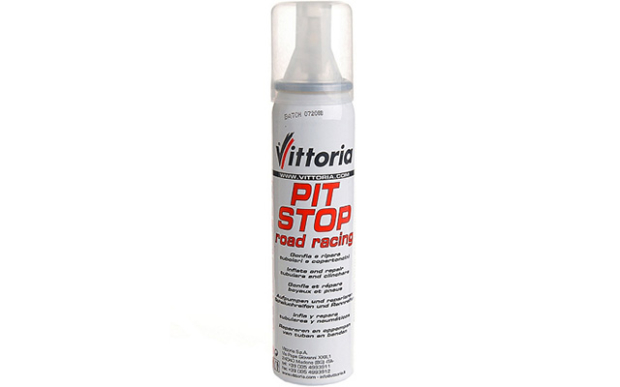
In general, I recommend pre-installed sealants over ‘fix-a-flat’ canisters. I prefer to do the work ahead of time in my garage, rather than on the road during a ride. Also, both rumors and my own tests show that canisters tend not to work as well as thicker, pre-installed sealants. To date, the only brand of ‘fix-a-flat’ canister that has actually fixed a flat for me is the Espresso product by Effetto Mariposa. If you’re going to go the canister route, I recommend it. Note that Co2 leaks out of tires faster than normal air, so a tire may seem flat after a day or two of using a canister. Try pumping the tire up to see if the seal held.
Current and Future Innovations
The major players are still out there – Stan’s, Effetto Mariposa, Slime, Orange Seal, Bontrager, Continental, Tufo, and a few others. All seem to be striving for that perfect mix of A) actually sealing punctures, B) not clogging the valve core, C) staying shelf stable (not separating or clumping up), and D) not evaporating quickly. If you’re using tubular tires or standard clinchers, you also have the option of glycol-based sealants, which tend to last much longer, at the expense of some sealing ability.
The new frontier is use-specific sealant products. For example, Orange Seal now offers an Endurance formula, because their original has a reputation for evaporating quickly (i.e. after 6 months or so). I haven’t yet tested the Endurance formula, so I don’t know the sealing ability compares to the original version.
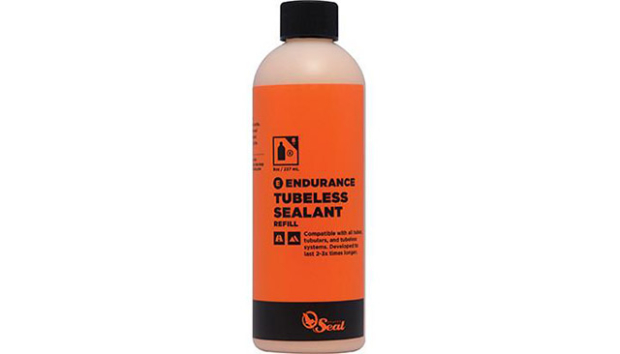
Effetto Mariposa also has an interesting twist that they’ve added to the line – Vitamina CL powder. For higher-risk riding, you can add this to their standard Caffelatex sealant, and they claim it reduces sealing time and seals larger size punctures.
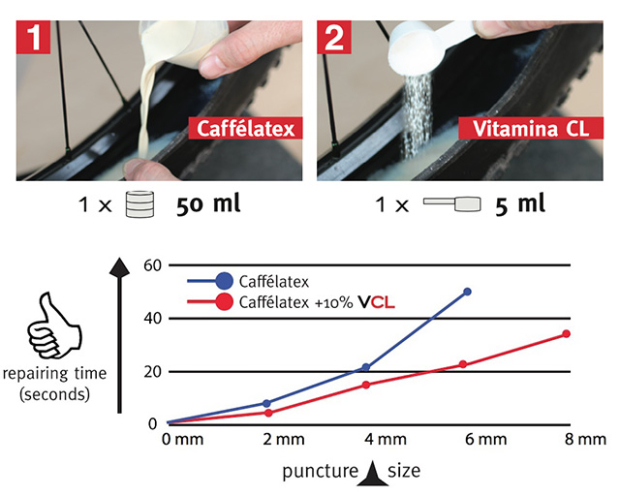
The take-home to me is that, despite my optimism, we’re largely in the same place we were ten years ago. Sealants certainly have their merit. For tubeless applications, they’re a must – but won’t likely save you from a very fragile tire choice. For inner tubes and tubulars, I see them as a nice race-day addition that might save your day – at the expense of a shorter shelf life for your tube or tire. Regardless of application, I advise that you only use valve stems with removable cores and buy a handful of spare cores (because they’re going to get gummed up and require replacement sooner rather than later).
Whether or not the juice is worth the squeeze – well, that’s up to you.



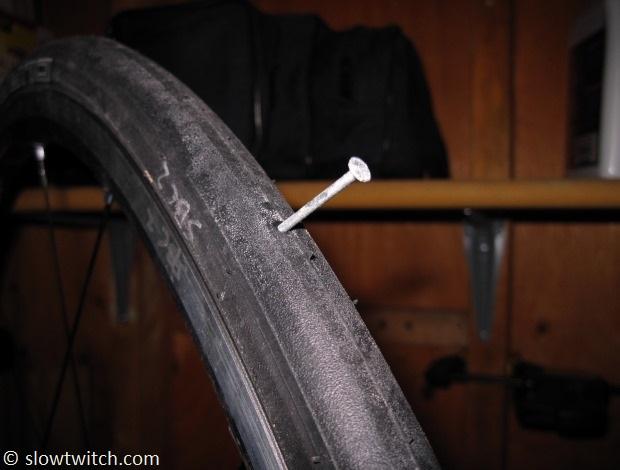

Start the discussion at slowtwitch.northend.network